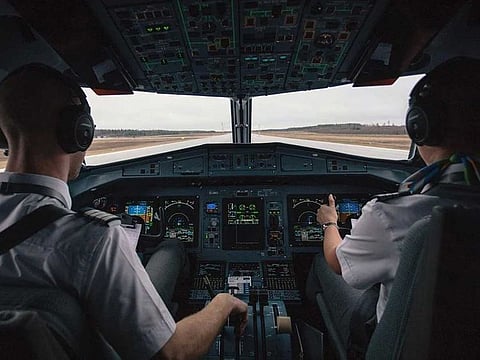Want to be a pilot? Middle East airlines will need 10,000 more by 2030
Middle East airlines face steep pilot gap by 2030 as hiring competition rises

Dubai: Middle Eastern airlines are heading into a decade of aggressive fleet growth without enough pilots to fly them, with new analysis warning of a shortage of more than 10,300 pilots by 2030. Unlike North America and Europe, where availability has begun to stabilise, the region remains on a steep hiring curve as carriers expand long-haul networks and launch new brands.
The Oliver Wyman report shows the Middle East will be the only region where demand for pilots continues to significantly outpace supply through the decade. The shortfall reflects record aircraft orders, strong long-haul demand and the rise of new Gulf hubs, all competing for qualified flight crew.
Carriers across the region have historically leaned on overseas talent, a trend expected to persist. Gulf airlines are likely to continue offering tax-free packages and fast-track opportunities to fly wide-body aircraft, competing for pilots from markets with surplus talent.
The talent gap comes alongside rising expectations among younger pilots, who now place greater weight on quality of life and schedule control than previous generations. That shift is reshaping incentive structures and could challenge traditional career ladders. The report notes pilots are increasingly favouring base stability and predictable rosters over rapid promotions.
At the same time, flight crew costs are rising faster than airline revenues, driven by higher pay and more flexible work rules. That dynamic is pushing airlines to adopt smarter crew-planning tools, bolster training capacity and accelerate investment in simulation, VR and AR training platforms to build local pilot pipelines.
“The Middle East faces a unique challenge: airlines are growing faster than the available pilot workforce,” said André Martins, Head of Transportation and Advanced Industrials for India, the Middle East, and Africa at Oliver Wyman. “With more than 10,000 pilots needed by 2030, carriers will have to think differently about sourcing, training, and retaining talent.
“Solutions such as localized training pipelines, advanced simulation, and innovative career pathways will be critical to sustaining growth.”
The report also highlights the growing use of part-time flying months, route-basing flexibility and enhanced mentoring programmes to attract and keep pilots. Airlines are increasingly tailoring training to diverse learning preferences, from immersive VR modules to data-driven curriculum design.
While the global pilot gap may ease over the second half of this decade, the Middle East is set to remain a magnet for pilots seeking long-range aircraft and tax-efficient pay. For the region’s airlines, the near-term focus is clear: scale training pipelines, modernise workforce systems and compete harder for talent to support one of the fastest-growing aviation markets in the world.
What this means for the UAE
Pilot training demand will surge
Local academies are likely to see rising enrolments and waiting lists, particularly in Dubai and Abu Dhabi, as carriers push to build domestic pilot pipelines and rely less on overseas recruitment.
Scholarships and cadet pathways set to expand
Expect more cadet programmes tied to major carriers and aviation schools, including structured funding support and post-training job pathways for UAE nationals and long-term residents.
Higher compensation floors and lifestyle incentives
Pilot pay is already strong in the region. With competition intensifying, carriers may introduce more predictable rosters, flexible contracts and base stability options to retain talent.
Simulation and tech-driven training will accelerate
VR, AR, AI-based assessment and data-driven learning models will enter mainstream training in local academies. This shortens training cycles and widens the funnel for future pilots.
More hiring for new airports and fleets
Al Maktoum International Airport’s expansion and new fleet orders from UAE carriers point to sustained hiring cycles beyond 2030. The talent requirement goes beyond pilots and covers flight instructors, engineers and safety roles.
Sign up for the Daily Briefing
Get the latest news and updates straight to your inbox




